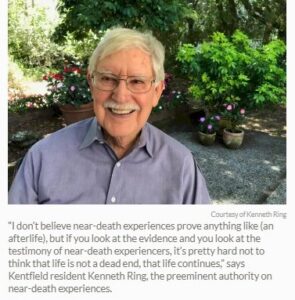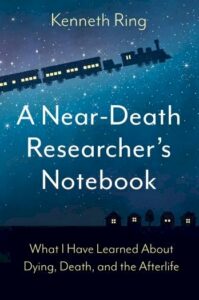This site uses affiliate links to Amazon.com Books for which IANDS can earn an affiliate commission if you click on those links and make purchases through them.
1. About the Author and the Journal
Vicki Larson is an author and has been an award-winning lifestyles editor, writer and columnist at the Marin Independent Journal since 2004. She has worked as an editor in Santa Rosa, Petaluma, Walnut Creek, San Francisco, Napa and Miami.
Established in 1861, the Marin Independent Journal is a daily newspaper covering Marin County in the Bay Area of Northern California.
The following is an article by Vicki Larson who is the Lifestyle Editor from the Marin Independent Journal.
2. At 87, Kenneth Ring, the Authority on Near-Death Experiences, is Ready to Die
By Vicki Larson
Kenneth Ring was in his mid-40s when he started to get interested in near-death experiences and the possibility of an afterlife. Death wasn’t something to fear, even his own.

After decades of researching NDEs, you might think there was nothing new to discover. You’d be wrong. Ring talks of what’s called “terminal lucidity,” when someone suffering from dementia or Alzheimer’s experiences an unexpected return of mental clarity and memory.
“The interesting thing is almost always in cases like this, that person is to die soon, often within a few hours,” he says. “It’s as if they awaken at the point when they’re about to make their transition and they’ve come to say goodbye. So people who are in this situation, if this was your grandmother who had this encounter, feel like they’ve been given a final gift. It leaves people kind of stunned and thrilled, and completely puzzled about how this can happen.”
It’s not a new phenomena and it’s relatively rare, but it’s finally being researched, he says.
And when Ring first started researching NDEs nearly a half century ago, many people who experienced it thought they were the only ones and often believed they were crazy, so they were reluctant to talk about it. That has changed as well.
3. New View of Death
“At the time that I was starting my research, this was very fringe-y and not well accepted by the medical profession, but now there’ been so much published about near-death experiences, hundreds if not thousands of articles written in the professional literature, so people are much more forthcoming about their near-death experiences these days than when I was starting out,” he says. “It’s given us a whole new view of death.”

Ring first learned about NDE after reading Raymond Moody’s 1975 book ”Life After Life,” one of the first best-sellers on the subject, when it was newly published. It was life-changing. As a professor of psychology at the University of Connecticut, Ring thought the subject needed someone grounded in research to do a deeper dive into it instead of the approach by Moody, a philosopher and physician. So he took it on.
He interviewed 102 near-death survivors, which informed his ground-breaking 1980 book, “Life At Death: A Scientific Investigation of the Near-Death Experience,” which was followed by six other books on NDEs. In 1980, he co-founded the International Association of Near-Death Studies and served as its president for several years. He also is the founding editor of the Journal of Near-Death Studies.
What he learned was that those who had near-death experiences had some commonalities, no matter if they were in an accident, on the operating table, suffering from a heart attack or even a suicide attempt, and whether they were religious or not. They all experienced similar feelings, images and sensations, including a profound peace and well-being, feeling separate from their physical body and moving through darkness toward a radiant light. Some had to decide if they’d like to continue or return to their body. And they are fundamentally changed.
4. Something More
They also believe that there’s some sort of life after death.
So does Ring.
“If you study near-death experiences and talk to hundreds of people as I have, you can’t help but feel that there’s something more to look forward to after we die. It almost beggars imagination. I don’t think there are any words that can fully describe what that experience is. I don’t believe near-death experiences prove anything like (an afterlife), but if you look at the evidence and you look at the testimony of near-death experiencers, it’s pretty hard not to think that life is not a dead end, that life continues. So I’m definitely open to the idea of an afterlife. I think the evidence is very strong,” he says.
“I was never interested in trying to prove life after death. I wasn’t interested in life after death as an issue, particularly. I was interested in what people could learn from having near-death experiences and what it can teach other people,” he says.
He did that in his 2000 book “Lessons from the Light: What We Can Learn from the NDE,” which has proven to be his most popular book and that Jenny Wade, a developmental psychologist, calls “a practical guide that motivates through its sheer heart-gripping beauty.”
And it’s helped shape his view on death, especially since he’s been living with spinal stenosis for the past six years that has recently gotten worse.
“You learn from talking to people who’ve had NDEs who almost universally attest that they are not afraid of death. You absorb something of their attitude and values toward life. So the result of all my studies and my personal experiences, yeah, I’m not afraid of death. I’m not looking forward to the dying part — I don’t want to suggest that that isn’t painful and difficult for many people. I don’t mean to dismiss that. Once you cross that threshold, it is such a positive experience.”
5. Teaching Moment
Ring’s latest book doesn’t just address NDEs. He also also tackles issues such as the ethics of the right-to-die movement, the epidemic of loneliness many Americans are experiencing, how COVID interfered with people’s abilities to be with love ones in their final hours — “I though that was one of the cruelest blows of COVID” — and the potential of using psychedelics to ally fears about death, as Michael Pollan has extensively written about.
Ultimately, his goal in all his books is to help people learn from people’s near-death experiences, especially since not everyone experiences it. It’s less about death and more about how to live, and how a “life review” allows us to see how our words, actions and behaviors impact others and the karmic justice that results.
“If everything that you do you basically get back, every good action that you do, every kindness that you express, you begin to experience that in the life review. And the things that you do that are nasty, you experience that as well. It’s not judgment, you’re not being condemned, you simply see them for what they are. You learn from them,” he says
In an interview with the New York Times in 1988, Ring, then in his 50s, shared he was not only not afraid to die, but that he was actually looking forward to it — but not too soon, he was quick to add.
Now that he’s in his late 80s, he’s still looking forward to it.
“I can barely wait.”














